Explanation of the Three-Bar Cross
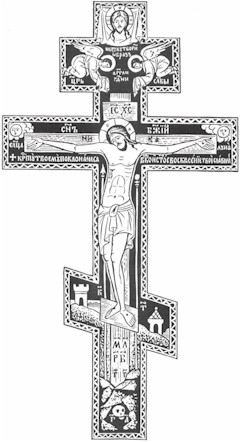 Through the Cross came our Salvation. We are constantly reminded that Christ died for us, and that He rose from the dead. The image of the crucified Lord reminds us of this.
On the Cross is our Savior, Jesus Christ. Note that He does not wear a crown of thorns, and that His feet are nailed with two nails. Behind the body of Christ, on either side, are a lance (which pierced Him) and a sponge (which was soaked with gall and offered to Christ to drink) on a pole made of reed or cane. On the body of Christ is depicted blood and water flowing forth from His side. Below the feet of Christ are four Slavonic letters meaning: "The place of the skull became Paradise". Hidden in a cave under the earth is 'the skull of Adam'. We are thus reminded that Adam our forefather lost Paradise through the tree from which he wrongly partook; Christ is the new Adam, bringing us Salvation and Paradise through the tree of the Cross. The city of Jerusalem is depicted in the background, for He was crucified outside the city walls.
Through the Cross came our Salvation. We are constantly reminded that Christ died for us, and that He rose from the dead. The image of the crucified Lord reminds us of this.
On the Cross is our Savior, Jesus Christ. Note that He does not wear a crown of thorns, and that His feet are nailed with two nails. Behind the body of Christ, on either side, are a lance (which pierced Him) and a sponge (which was soaked with gall and offered to Christ to drink) on a pole made of reed or cane. On the body of Christ is depicted blood and water flowing forth from His side. Below the feet of Christ are four Slavonic letters meaning: "The place of the skull became Paradise". Hidden in a cave under the earth is 'the skull of Adam'. We are thus reminded that Adam our forefather lost Paradise through the tree from which he wrongly partook; Christ is the new Adam, bringing us Salvation and Paradise through the tree of the Cross. The city of Jerusalem is depicted in the background, for He was crucified outside the city walls.
The Top Bar
The top bar is the title-board which Pilate 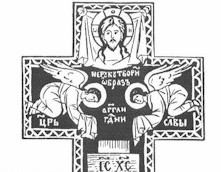 ordered to be hung in mockery over Christ’s head on the Cross. On this board was inscribed: "Jesus of Nazareth, King of the Jews" in Hebrew, Greek, and Latin (abbreviated to the Greek initials ‘INBI’ or the Latin initials ‘INRI’ in the Western tradition). This is replaced with the Christian inscription: "King of Glory" – below the knees of the angels. On the title-board is inscribed the initials 'IC XC', being the first and last letters of Christ’s name in Greek. In addition, just above Christ's arms we see the inscription: ‘NIKA’, which in Greek means: "He conquers" or "He is victorious." Frequently, we see these last two inscriptions together: 'IC XC NIKA', meaning: "Jesus Christ is victorious" (over death and sin).
ordered to be hung in mockery over Christ’s head on the Cross. On this board was inscribed: "Jesus of Nazareth, King of the Jews" in Hebrew, Greek, and Latin (abbreviated to the Greek initials ‘INBI’ or the Latin initials ‘INRI’ in the Western tradition). This is replaced with the Christian inscription: "King of Glory" – below the knees of the angels. On the title-board is inscribed the initials 'IC XC', being the first and last letters of Christ’s name in Greek. In addition, just above Christ's arms we see the inscription: ‘NIKA’, which in Greek means: "He conquers" or "He is victorious." Frequently, we see these last two inscriptions together: 'IC XC NIKA', meaning: "Jesus Christ is victorious" (over death and sin).
The Middle Bar
 The middle bar is that on which the Lord's hands were nailed. On either top corner we see the depiction of the sun (left) and the moon (right), for "The sun hid its light, and the moon turned to blood." (Joel 2:31) The inscription: "Son of God" is placed on both sides of Christ's head, and below His arms we read the inscription: "Before Thy Cross we bow down, O Master, and Thy holy Resurrection, we glorify". The halo of Christ is inscribed with three Greek letters meaning "The Being" or "He Who Is", to remind us that Christ is the same God Who identified Himself with those words to Moses in the Old Law.
The middle bar is that on which the Lord's hands were nailed. On either top corner we see the depiction of the sun (left) and the moon (right), for "The sun hid its light, and the moon turned to blood." (Joel 2:31) The inscription: "Son of God" is placed on both sides of Christ's head, and below His arms we read the inscription: "Before Thy Cross we bow down, O Master, and Thy holy Resurrection, we glorify". The halo of Christ is inscribed with three Greek letters meaning "The Being" or "He Who Is", to remind us that Christ is the same God Who identified Himself with those words to Moses in the Old Law.
The Bottom Bar
The slanted bottom bar is the foot-rest. There is some question of whether it was actually on the Cross of Christ, but it is acknowledged to be a necessary attribute of the Cross, worthy of veneration and prophetically alluded to in the words [Let us] worship the footstool of His feet... (Ps. 98:5).
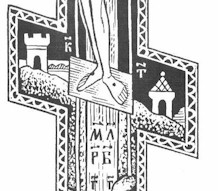 In prayers for the Ninth Hour, the Church likens the Cross to a type of balance of righteousness:
In prayers for the Ninth Hour, the Church likens the Cross to a type of balance of righteousness:
"Between two thieves Thy Cross did prove to be a balance of righteousness: wherefore one of them was dragged down to Hades by the weight of his blasphemy whereas the other was lightened of his transgressions unto the comprehension of theology. O Christ God, glory to Thee."
The meaning of this prayer is as follows: the Cross of Christ stood for a scale of justice between the two thieves: for one of them sank in to hell, dragged down by his blasphemous words; and the other, the wise thief, ascended into heaven, because of his repentance. The church fathers attempted to render tangible the thought of the unfaithful theif going to hell for his blasphemy throught the just judgement of God (the lower end of the bar), and of the wise thief going to heaven for his repentance and his praise of God (the upper end).
Volume IV, No. 3; May-June 1982 Living Orthodoxy was used as a source for some material on this page.
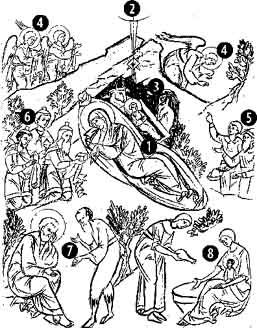 of the other figures, reclining on a mat, and looking not at her new-born Son, but rather with love and compassion towards her spouse, St Joseph the Betrothed (7), seeing his affliction and bewilderment over this most strange and divine birth;. He is shown in the left bottom corner, conversing with Satan, disguised as an old shepherd. The posture of St Joseph is one of doubt and inner trouble, for he wondered if it might be possible that the conception and birth were not by some secret human union; how blessed he was to serve the Mother of God and her divine Son, in spite of these thoughts and temptations, and to protect her from the evil gossip of the people who could not yet possibly understand so great a mystery. Our Lord is shown in swaddling clothes and lying in a manger, "for there was no room for them in the inn." (cf. Luke 2) The back-drop for the manger is a dark cave (3), which immediately reminds us of the cave in which our Lord was buried 33 years later, wrapped in a shroud. In the cave are an ox and ass, details not mentioned by the Gospels, but which are an invariable feature of every icon of the Nativity; the scene is included to show the fulfillment of the words of the prophet Isaiah, "the ox knows his Owner, and the ass his Master's crib, but Israel does not know Me, and the people has not regarded Me" (Isaiah 1:3). (2) Above this central composition, in the very center of the icon is the wondrous star coming from heaven, which led the magi (6) to the place where our Savior lay; It reminds us of the heavenly orb we see on icons of the Theophany, or Pentecost, wherever divine intervention is indicated.
of the other figures, reclining on a mat, and looking not at her new-born Son, but rather with love and compassion towards her spouse, St Joseph the Betrothed (7), seeing his affliction and bewilderment over this most strange and divine birth;. He is shown in the left bottom corner, conversing with Satan, disguised as an old shepherd. The posture of St Joseph is one of doubt and inner trouble, for he wondered if it might be possible that the conception and birth were not by some secret human union; how blessed he was to serve the Mother of God and her divine Son, in spite of these thoughts and temptations, and to protect her from the evil gossip of the people who could not yet possibly understand so great a mystery. Our Lord is shown in swaddling clothes and lying in a manger, "for there was no room for them in the inn." (cf. Luke 2) The back-drop for the manger is a dark cave (3), which immediately reminds us of the cave in which our Lord was buried 33 years later, wrapped in a shroud. In the cave are an ox and ass, details not mentioned by the Gospels, but which are an invariable feature of every icon of the Nativity; the scene is included to show the fulfillment of the words of the prophet Isaiah, "the ox knows his Owner, and the ass his Master's crib, but Israel does not know Me, and the people has not regarded Me" (Isaiah 1:3). (2) Above this central composition, in the very center of the icon is the wondrous star coming from heaven, which led the magi (6) to the place where our Savior lay; It reminds us of the heavenly orb we see on icons of the Theophany, or Pentecost, wherever divine intervention is indicated.